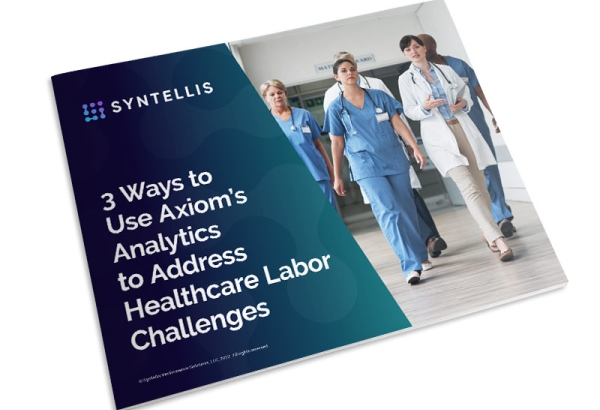Challenges associated with ongoing workforce shortages take many different forms in healthcare organizations: One health system may struggle to flex staff to patient demand, another may need to improve staff efficiencies, and yet another may need to better communicate staffing needs between clinical departments and finance.
Hospitals, health systems, and other healthcare providers nationwide face unprecedented competition for qualified healthcare professionals. Wide spread workforce shortages are driving up hospitals’ total labor costs and contributing to multiple consecutive months of year-over-year hospital operating margin declines, according to recent Syntellis data.
Learn how leaders from three health systems use Syntellis’ Axiom healthcare analytics and reporting tools to help navigate workforce challenges by:
- Measuring and monitoring productivity
- Improving staff efficiencies
- Identifying and addressing under-resourced areas
Measure and Monitor Productivity
Like many health systems, South Dakota-based Monument Health struggled to adjust staffing levels as patient demand fluctuated. With Axiom™ Productivity Reporting, the five-hospital system now easily manages staff schedules and productivity.
Health system leaders use the healthcare analytics platform to calculate headcount to full-time equivalents (FTEs) based on factors such as time of day, days worked, and number of caregivers required based on patient needs. That information feeds into other systems at Monument Health, unifying its scheduling, position control, budgeting, and productivity processes.
Axiom Productivity Reporting also helps health system leaders track performance, including how departments are performing relative to targets. The solution aggregates organizational data and generates visual dashboards, so leaders across Monument Health can see performance easily. The productivity reports provide insights that reveal why teams are outside productivity targets, and help leaders create plans to get departments back on track.
Improve Staff Efficiencies
In Pennsylvania, leaders at Lehigh Valley Health Network (LVHN) sought to optimize efficiencies for the health system’s 20,000 staff members. Axiom™ Comparative Analytics helps LVHN leaders gauge how many FTEs are needed to meet patient demands and optimize efficiencies using these capabilities:
- Productivity reporting to monitor volume-driven staffing compared to actual patient volumes
- Labor budgeting to more accurately measure FTEs needed for each department
- Benchmarking to provide external comparisons for staffing budgets, productivity, care quality, and patient satisfaction
LVHN leaders chose Axiom Comparative Analytics because of its timely, accurate, and user-friendly data, said Kyle Davison, the health system’s Manager of Management Engineering. Previous healthcare analytics solutions LVHN used were labor-intensive and didn’t provide timely data or an appropriate array of benchmark comparison groups.
“We have an 800-bed hospital, ambulatory surgery units, and small, community-based hospitals, and we need solutions that work for all of them,” Davison said.
With more than 300 department types to map against, Axiom Comparative Analytics empowers the health system to customize data by department and units of service to assess where to adjust staffing and operations. LVHN has avoided $3.3 million in labor costs for its patient care services as a result, Davison added.
Identify and Address Under-Resourced Areas
Carle Health in Illinois wanted to use data to help illustrate staffing needs and address workforce inefficiencies. This required more effective communication between finance and clinical operations. Having the right data and presenting it in a clear way helped bridge the gap between the clinical and administrative sides of the organization, said Patricia Singer, Carle Health’s former Patient Care Manager.
“You’re basically painting a picture with data to support your ask and validate that you’ve done everything you can to make sure you’re being efficient and fiscally responsible,” says Singer.
Carle Health — which includes five hospitals, multi-specialty physician groups, and a research institute — uses Axiom™ Performance Reporting to monitor operational efficiencies. With this healthcare analytics solution, the health system tracks volume on an hourly basis as patient demand fluctuates throughout the day. Staffing variance reports analyze worked hours per unit of service to determine how many staff members are needed at any given time, better predict future staffing needs, and influence hiring decisions.
By using health analytics software to compare Carle Health’s performance to similar organizations with external benchmarking, the health system can also adjust staffing and operations to optimize performance and patient satisfaction.
“This helps us see how we align and identify areas where we can improve,” Singer said. “We know if we don’t have enough providers and our patient satisfaction scores aren’t where we would like them to be, that shows there’s somewhere that we need to make an improvement.”
Leverage Data to Confront Labor Challenges
Challenges associated with ongoing workforce shortages are expected to intensify in coming years as healthcare professionals retire or seek other jobs in response to burnout, competitive wages, and new opportunities. Health analytics platforms equipped with robust data capabilities are essential for healthcare organizations seeking to provide high-quality, cost-effective patient care on an ongoing basis.
With a new approach to managing efficiency and operations, healthcare organizations can overcome these challenges without hindering patient care or organizational performance.

3 Ways to Use Axiom's Analytics to Address Healthcare Labor Challenges

Healthcare’s Mounting Labor Challenges Strain Hospital Expenses, Operating Margins


